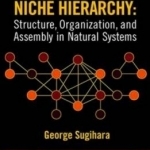Niche Hierarchy: Structure, Organization, and Assembly in Natural Systems
BookThis item doesn’t have any media yet
2015 | Reference
This book is the 1982 Thesis of Dr. George Sugihara and represents an early attempt to produce a unifying theoretical synthesis to tie together four disparate areas of ecology: 1) the topological structure of food webs, 2) ecosystem dynamics, 3) ecosystem/food web assembly, and 4) universal patterns of species abundance. The work is based on the premise that deep general principles are likely to be associated with general widely observed empirical regularities, and is organized around uncovering and explaining such patterns for each of the four research areas, and then showing how they are interrelated. The work has historic interest as a pioneering attempt at unification, and remains ambitious and current in its findings and overall scope. This is the first rigorous application of algebraic topology and one of the earliest applications of graph theory to ecology. Professionals interested in food web dynamics and their relation to niche function, structure and hierarchy, in natural systems, will find this a valuable resource. Key Features* Contains one of the earliest food web data atlases.*
Shows the development of several novel data-transformation models (transformations of empirical food web matrices) based on graph theory and algebraic topology* Includes Sugihara's "Resource Graph", the "Consumer Overlap Graph" and the "Simplicial Complex" model of the niche.* Finds that the simplicial complexes of real niche spaces do not have holes but are densely packed.* Finds that chordality (triangulation) is a ubiquitous topological feature of food webs that can explain food web intervality (1-dimensional niche structure) and food web assembly.* Demonstrates the first, and only, empirical ecological assembly rule mathematically deduced from data. The basic idea of conservative assembly with an underlying ordering of resources became the basis of current methods for generating model foodwebs.* Shows the relationship between chordality, lack of holes, and conservative food web assembly, and how these more fundamental properties explain the prevalence of intervality.* Relates the observed topological regularities and the assembly rule to higher dynamic stability in model ecosystems.*
Shows how the specific topological features uncovered in food webs resonate with the niche hierarchy model of species abundance - a model with no free parameters that reproduces two universal empirical regularities in ecological species-relative-abundance data (the ubiquitous canonical lognormal species abundance distribution and the species area constant z=1/4) .
Related Items:
| Published by | J Ross Publishing |
| Edition | Unknown |
| ISBN | 9781604271287 |
| Language | N/A |
Images And Data Courtesy Of: J Ross Publishing.
This content (including text, images, videos and other media) is published and used in accordance
with Fair Use.
